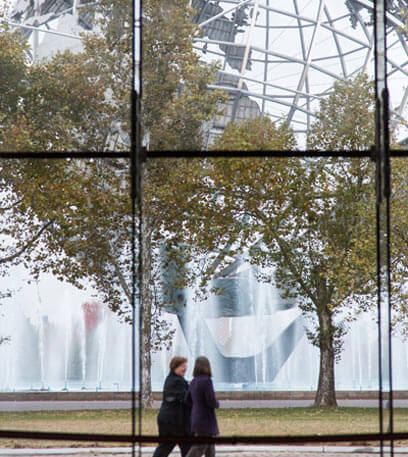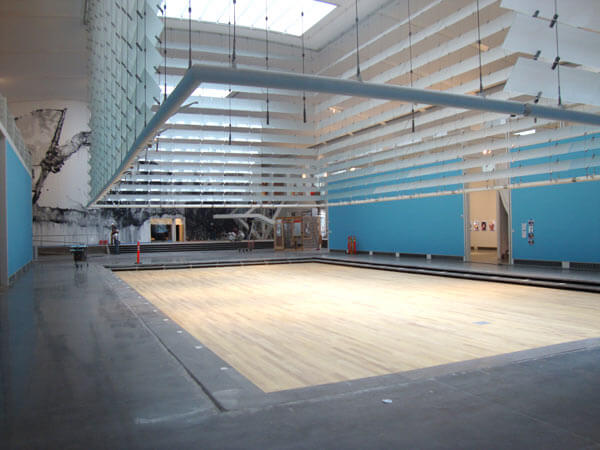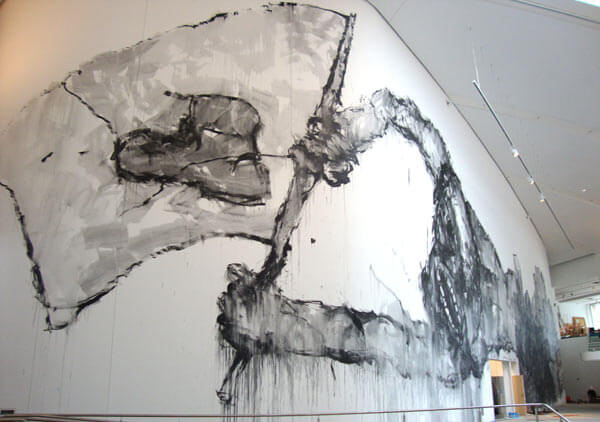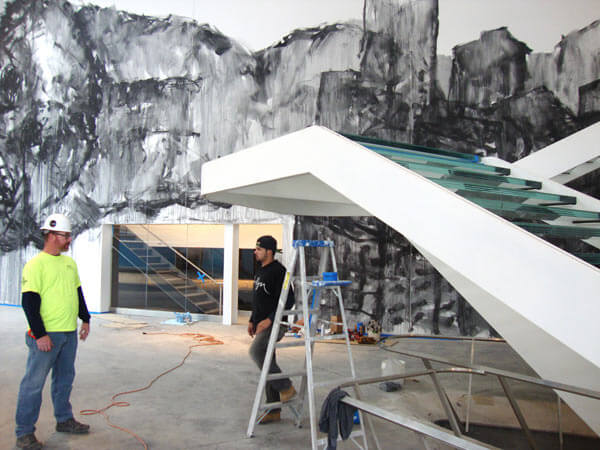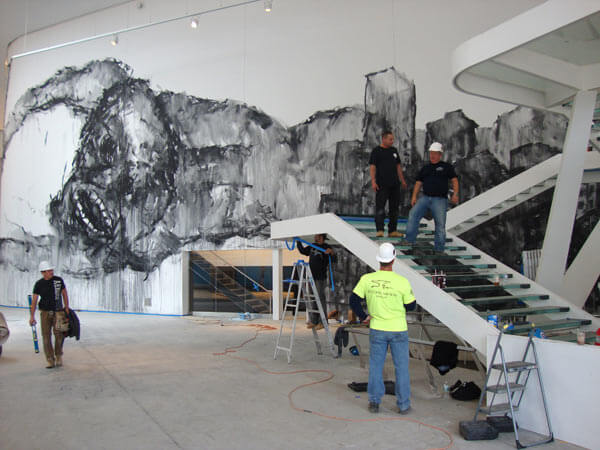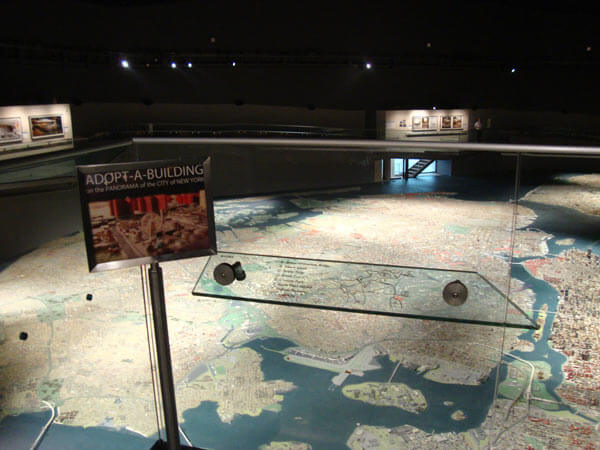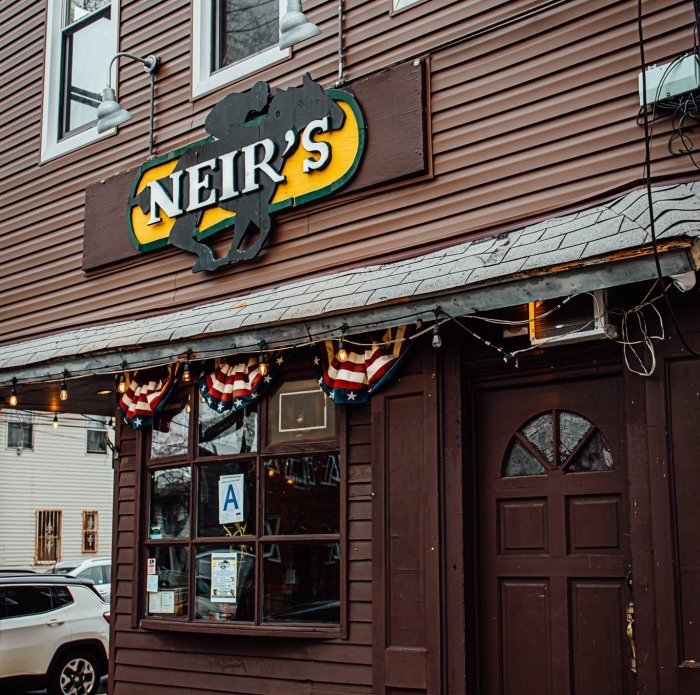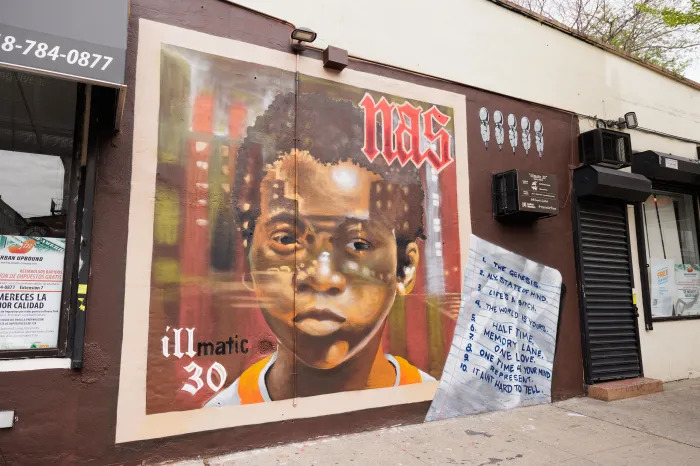By Kevin Zimmerman
Although it dropped the word from its name, art remains the focal point of the new Queens Museum as it reopens after an eight-year, $69 million renovation project Saturday.
As part of its expansion to 105,000 square feet, the museum now includes nine artist studios, six new gallery spaces and a 40-by-100-foot blank wall in the new entryway, which will display a series of rotating murals throughout the year. Officials hope all of this will add up to a slew of new visitors, who will spend more time at the museum.
“People were often surprised when they got here how good it was,” Tom Finkelpearl, executive director of the museum, said. “That says the product is good but the image is not. Now, we want people’s expectations to be high coming in.”
That starts with the building, which now includes a flourish of artistic touches blurring the line between form and function.
Architecture firm Grimshaw, working with design consultants Ammann & Whitney, replaced walls from both the western Grand Central Parkway and eastern Flushing Meadows Corona Park sides of the structure with huge plate glass windows and doorways that are transparent rather than reflective, flooding the new entry hall with natural light.
Light also pours in from above through a series of new skylights, which cut across the roof of the main gallery, filtering sun rays through a series of hanging glass tiles that fill the upper half of the renovated cavernous space.
“If there were one word to describe the museum, it would be openness,” said Dave Strauss, executive director of external affairs and capital projects for the museum. “We really wanted to celebrate the symbiosis between the museum, the community and the park.”
This sense of wide-open spaces actually begins outside the building on either side.
Once hidden from the Grand Central Parkway by a copse of trees, an area the length of the building has been cleared — and trees moved and replanted to other parts of the park — eliminating any barrier between the museum and passing motorists.
A single piece of stainless steel bisects the building’s façade creating a canopy over the revolving doors.
Above this, walls have been swapped out with glass panels equipped with LED lighting. This will allow the museum to commission artists to create light shows related to current exhibitions.
The whole design works on multiple levels, Strauss said.
First it creates a compressed space at the entry point. This serves to take visitors from the vast outdoors, funnel them through a much smaller opening, then move them into an area with soaring 48-feet ceilings. It also allows the museum to serve as an opening to Flushing Meadows Corona Park.
Openness also describes the eastern/park side entryway to the building.
Alternating floor-to-ceiling glass panels with the old masonry façade, this side provides unobstructed views of the Unisphere and park beyond. For the visitor, this creates a sense of being out in the park even inside the building.
“We have pushed the façade back so you are simultaneously in the park and in the footprint of the museum,” Strauss said.
But this lack of separation between indoors and outdoors extends even further with the creation of what the museum calls its new front porch — an expanded outdoor seating area that will be used for museum programs and available to anyone who visits the park.
But when visitors step into the renovated building their eyes will likely be drawn to artist Peter Schumann’s two-story tall black, white and gray mural depicting a grimacing figure clutching a flag with an image of a hiking boot across the banner’s field.
Museum officials selected Schumann, founder and director of the Bread and Puppet Theater, for its first solo exhibition.
“The Shatterer” consists of two large installations including paintings, drawings, papier-mâché sculptures and handmade books. The two rooms, bathed in black, white and gray, utilize objects from Schumann and his theater dating back 50 years. The artist is also scheduled to stage solo performances in the smaller of the two galleries he has dubbed “The Chapel” between now and March.
Museum visitors will now have regular access to presentations and workshops by artists in the nine new studios created in the original half of the museum’s ground floor. About 400 artists applied for the first round of year-long residences and the nine selected have been ensconced in the new studio wing since the summer.
On opening day, the museum has scheduled its first open studio event.
“This is an immersive residency,” Strauss said. “We don’t want them to stay in their studios. We are going to have educational programs and programs just for the artists led by our staff members and outside people.”
Other additions include a relocated museum shop constructed with glass walls, a café and a new entry — cut into the mural wall of the new entrance hall — to the iconic Panorama of the City of New York exhibit. But other than a fresh coat of paint and new carpeting, the Panorama remains the same.
Also under the heading of everything old is new again, the museum has moved its exhibit “From Watershed to Faucets: The Marvel of New York City’s Water Supply System” into one of the new galleries. Next door will be the “Neustadt Collection of Tiffany Glass,” along with an first-ever examination of Tiffany’s work at its various studios around Corona.
Then, in 2015, the Queens Library opens a full-branch at the museum, which will showcase material related to ongoing exhibits.
As for the exhibit that may be the museum’s raison d’être — its collection of more than 10,000 items related to the 1939 and 1964 World Fairs — the newly installed “World’s Fair Visible Storage and Gallery” on the second floor celebrates the building’s beginning as the New York State exhibition hall at both events. From pennants to small-scale models of the long-gone exhibition buildings, visitors can spend hours perusing the 900 items on display.
For Finkelpearl, that would mean the project was a success.
Museum directors tend to view any guest visit under two hours as a sort of failure, said Finkelpearl. Someone who spends a hour or so getting to an institution and then only stays for about an hour isn’t likely to return.
So the key, Finkelpearl said, is to ensure a visitor can easily make a day of it.
“The idea is to come here and spend the whole afternoon,” Finkelpearl said. “I think now we are able to fulfill that. So this widens the audience and raising the ante over all.”
Reach news editor Kevin Zimmerman at 718-260-4541 or by email at kzimmerman@cnglocal.com.

